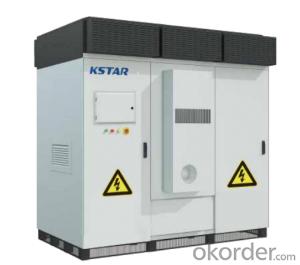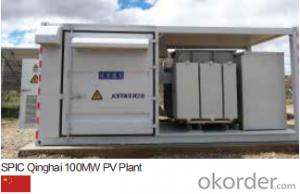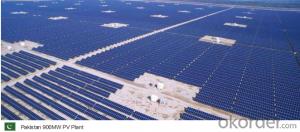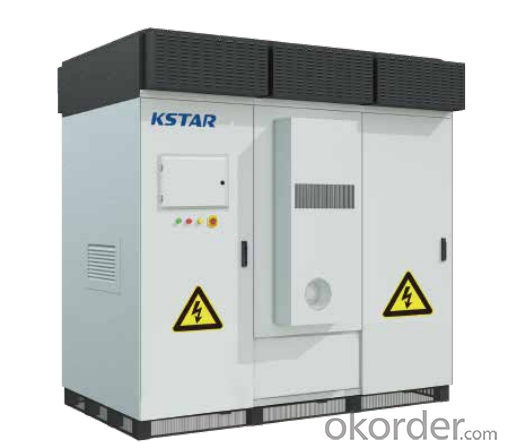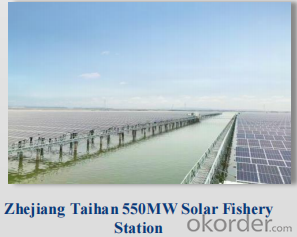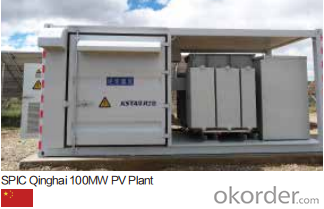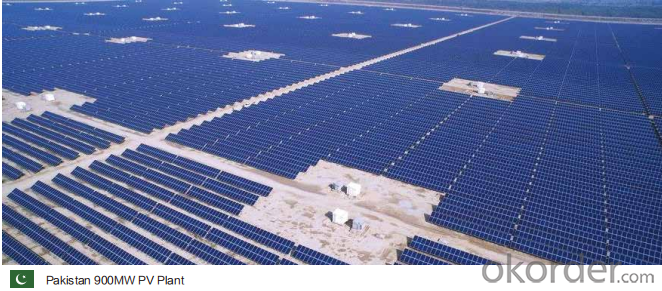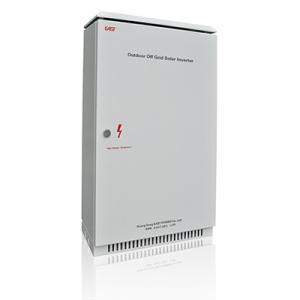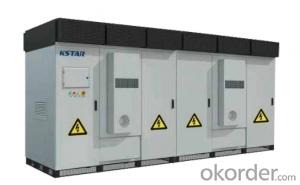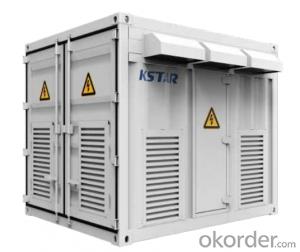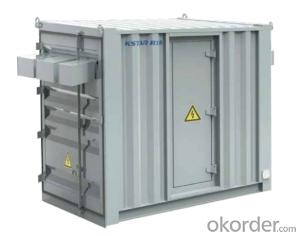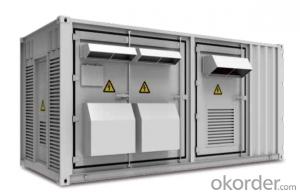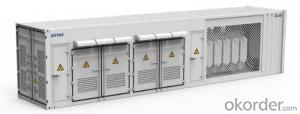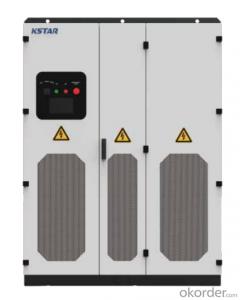8 Kw Solar Inverter DC1500V Container Solution GSM2500D / GSM3125D
- Loading Port:
- China main port
- Payment Terms:
- TT OR LC
- Min Order Qty:
- 50 pc
- Supply Capability:
- 15000 pc/month
OKorder Service Pledge
OKorder Financial Service
You Might Also Like
Specification
Product Description:
★Max. PV voltage up to 1500V Max. 24 DC inputs
★IP55 outdoor protection Modular design for Easy maintenance
★Max. DC/AC ratio up to 1.8 Full power output under 55℃
★AGC/AVC Night SVG function LVRT/HVRT/FRT function
Technical Specifications:
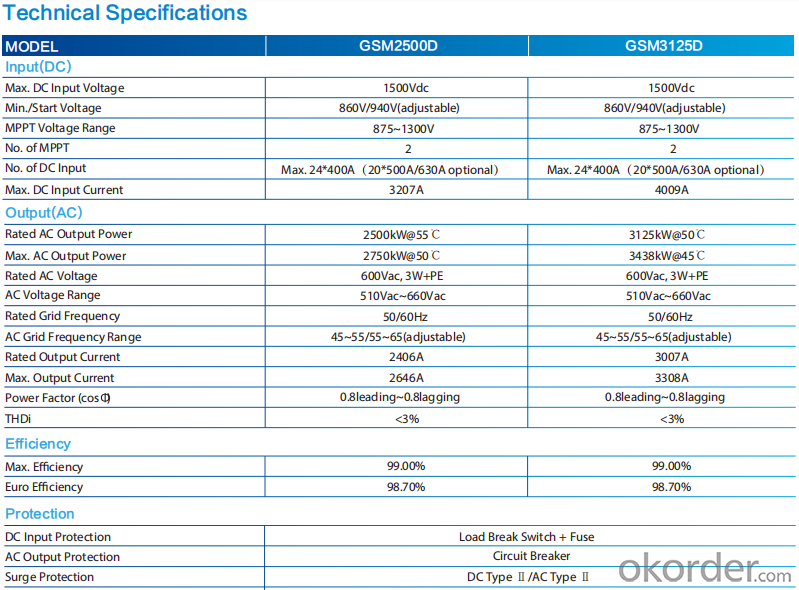
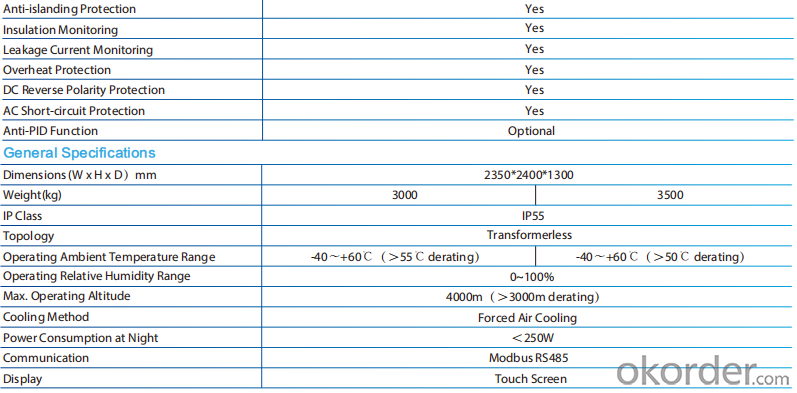
FAQ:
Q:How the output voltage of the PV inverter and the grid-connected voltage are determined
Inverter is the DC power (battery, battery) into alternating current (usually 220V, 50Hz sine wave). It consists of inverter bridge, control logic and filter circuit. Widely used in air conditioning, home theater, electric wheel, power tools, sewing machines, DVD, VCD, computer, TV, washing machine, range hood, refrigerator, video recorders, massage, fan, lighting and so on. In foreign countries
Q:Installation and maintenance of photovoltaic grid - connected inverter
only when the local power sector permission by the professional and technical personnel to complete all the electrical connection before the inverter can be connected.
Q:What is the difference between a PV grid-connected inverter and an off-grid inverter?
Off-grid inverter is equivalent to their own to establish an independent small power grid, mainly to control their own voltage, is a voltage source.
Q:After the PV inverter, how to achieve the same period before the network?
Solar panel simulator: with MPPT function, simulated morning, noon, afternoon, evening, rainy weather, solar panels produced under different conditions in different voltages.
Q:Is the PV inverter a current source or a voltage source?
According to the waveform modulation method can be divided into square wave inverter, stepped wave inverter, sine wave inverter and modular three-phase inverter.
Q:Photovoltaic grid-connected inverter without DC emc how will happen
Solar photovoltaic power generation technology is the use of solar cells, the photovoltaic effect of semiconductor materials, solar radiation can be directly converted into a new type of power generation system, solar energy is a radiant energy, solar power means --- to direct conversion of sunlight Into electricity,
Q:What is the difference between low voltage grid connection and medium voltage grid connection?
For photovoltaic power plants when the power system accidents or disturbances caused by photovoltaic power plant grid voltage drop, in a certain voltage drop range and time interval, the photovoltaic power plant can ensure that non-off-line continuous operation.
Q:Is the grid side of the grid and the inverter?
The grid load side of the grid is the grid. The inverter is an important part of the PV grid-connected system and can not be regarded as an external load. Photovoltaic power generation system is included in both grid and off-grid.
Q:PV grid-connected inverter and independent inverter in the control of what is the difference
The independent inverter in the output voltage phase amplitude of the frequency control is initially set good. Independent inverter, you should refer to off-grid inverter, do not need to consider the grid situation.
Product Images:
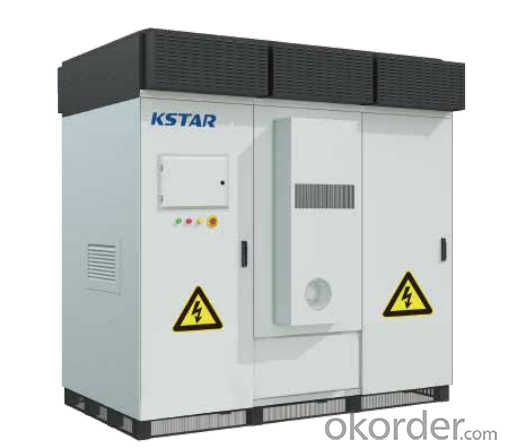
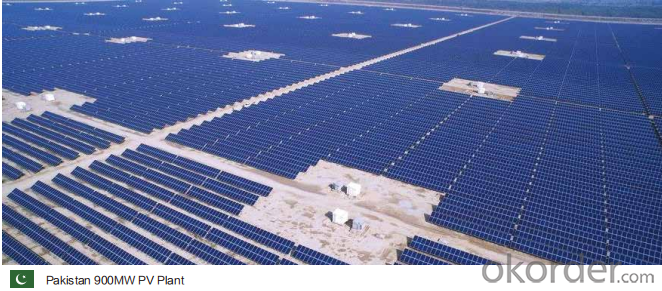
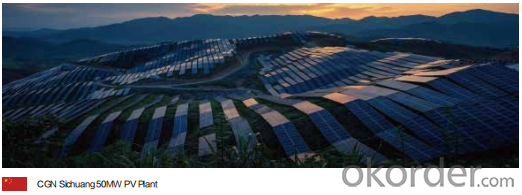

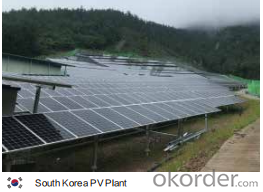
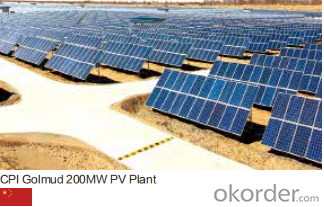
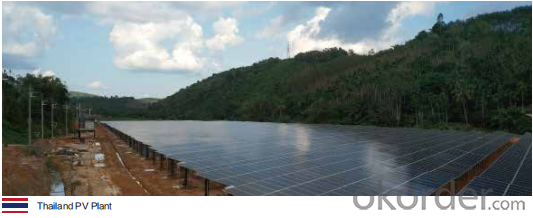
Production Process Photos:
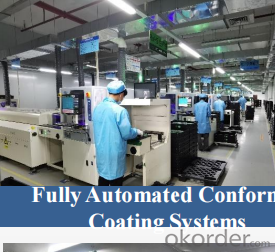
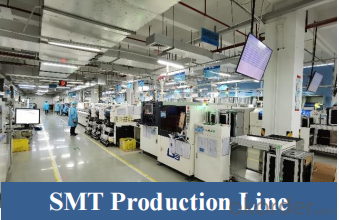
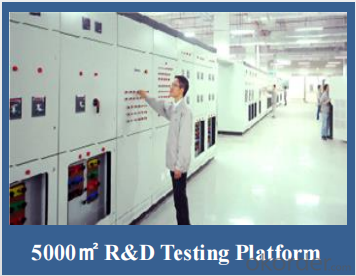
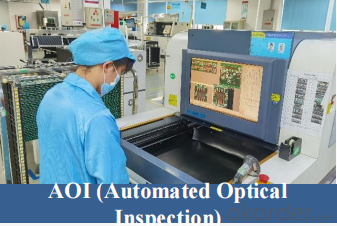
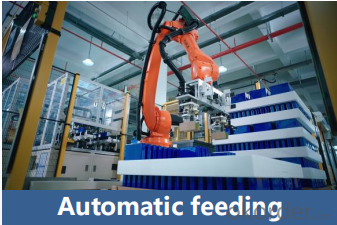
- Q: Can a solar inverter be upgraded or expanded?
- Yes, a solar inverter can be upgraded or expanded. Upgrades may involve adding new features or improving the efficiency of the existing inverter. Expansion typically refers to increasing the capacity of the inverter to accommodate additional solar panels. However, the extent to which an inverter can be upgraded or expanded varies depending on the specific model and manufacturer.
- Q: Can a solar inverter be used with a smart home automation system?
- Certainly! A smart home automation system can indeed work together with a solar inverter. Nowadays, many solar inverters come with communication capabilities built-in, like Wi-Fi or Ethernet connectivity. This means that they can easily be integrated into a smart home automation system. This integration allows homeowners to remotely monitor and control their solar power production and usage using a smartphone app or a central control panel. By having a smart home automation system, users can keep track of real-time energy generation, make adjustments to settings, and receive notifications about system performance or any potential issues. This integration not only enhances the convenience and efficiency of managing solar power but also enables better optimization and synchronization with other smart devices and appliances in the household.
- Q: Can a solar inverter be used with a solar-powered swimming pool heater?
- Yes, a solar inverter can be used with a solar-powered swimming pool heater. The solar inverter is responsible for converting the DC (direct current) electricity produced by the solar panels into AC (alternating current) electricity that can be used to power the swimming pool heater.
- Q: Can a solar inverter be used in systems with different module efficiencies?
- Yes, a solar inverter can be used in systems with different module efficiencies. Solar inverters are designed to convert the DC power generated by solar panels into AC power, regardless of the module efficiency. The inverter's main function is to optimize the power conversion process and ensure compatibility between the solar panels and the electrical grid. As a result, it can accommodate varying module efficiencies and still function efficiently.
- Q: What is maximum power point tracking (MPPT) in a solar inverter?
- The technique known as maximum power point tracking (MPPT) is employed in solar inverters for the purpose of optimizing the power output of a photovoltaic (PV) system. When solar panels are exposed to sunlight, they generate electricity, but the amount of power they produce can vary depending on factors such as temperature, shading, and the angle at which sunlight strikes them. The maximum power point (MPP) is the specific point at which a solar panel generates the greatest amount of power given the prevailing environmental conditions. However, because these conditions are constantly changing, it is crucial to continuously track the MPP in order to ensure that the solar panels achieve the highest possible power output. Solar inverters equipped with MPPT functionality employ advanced algorithms and electronics to continuously monitor the voltage and current output of the solar panels. By dynamically adjusting the operating voltage and current to align with the MPP, the MPPT inverter ensures that the solar panels operate at their most efficient, regardless of how the environmental conditions may change. When the solar panels are functioning at their MPP, the MPPT inverter extracts the maximum amount of power from the panels and converts it into usable AC power. This optimization leads to increased overall energy generation and maximizes the return on investment for solar power systems. In addition to enhancing efficiency, MPPT also provides other advantages. It can compensate for fluctuations in solar irradiation, temperature, or shading that might impact the power output of the panels. By continually tracking the MPP, the MPPT inverter adjusts the operating parameters to minimize the impact of these factors, ensuring a consistent and optimal power output. In summary, MPPT is a critical feature in solar inverters as it maximizes the power output of a PV system by continuously tracking and adjusting the operating parameters to align with the MPP. This technology enables solar power systems to operate at their highest efficiency, enhance energy generation, and maximize the benefits of utilizing renewable energy sources.
- Q: What is the role of MPPT (Maximum Power Point Tracking) in a solar inverter?
- The role of MPPT (Maximum Power Point Tracking) in a solar inverter is to optimize the efficiency of the solar panel system by continuously adjusting the voltage and current to ensure that the panel operates at its maximum power point. This helps to extract the maximum available power from the solar panels under varying environmental conditions, such as changes in sunlight intensity or temperature. By dynamically tracking the optimal operating point, MPPT maximizes the energy output of the solar panels and improves the overall performance of the solar inverter system.
- Q: What is the role of a voltage regulation feature in a solar inverter?
- The role of a voltage regulation feature in a solar inverter is to ensure that the voltage output from the solar panels is maintained at a stable and optimal level. This helps to protect the sensitive electrical components in the solar inverter and other connected devices, while also maximizing the efficiency and performance of the solar power system.
- Q: What are the key factors affecting the reliability of a solar inverter?
- The key factors affecting the reliability of a solar inverter include the quality and durability of its components, such as the semiconductor devices, capacitors, and transformers. The design and manufacturing processes also play a significant role, as well as the overall system integration and installation. The environmental conditions, such as temperature, humidity, and dust levels, can impact the inverter's reliability, along with the quality of the electrical grid and the stability of the solar power generation. Regular maintenance and monitoring are crucial for identifying and addressing any potential issues that may arise, ensuring the long-term reliability of the solar inverter.
- Q: How does a solar inverter handle electromagnetic interference?
- A solar inverter handles electromagnetic interference by incorporating various filtering techniques and components to minimize the impact of electromagnetic interference on its operation. This includes using electromagnetic compatibility (EMC) filters, shielding, and proper grounding techniques. These measures help to reduce electromagnetic emissions from the inverter and also protect it from external electromagnetic disturbances, ensuring reliable and efficient operation.
- Q: Can a solar inverter work in low light conditions?
- Yes, a solar inverter can work in low light conditions. While the output power of a solar inverter may decrease in low light conditions, it is still capable of converting the available sunlight into usable electricity. The performance may vary depending on the specific model and technology used, but modern solar inverters are designed to work efficiently even in low light situations.
Send your message to us
8 Kw Solar Inverter DC1500V Container Solution GSM2500D / GSM3125D
- Loading Port:
- China main port
- Payment Terms:
- TT OR LC
- Min Order Qty:
- 50 pc
- Supply Capability:
- 15000 pc/month
OKorder Service Pledge
OKorder Financial Service
Similar products
Hot products
Hot Searches
Related keywords
